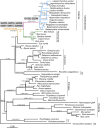Accelerated Evolution of Limb-Related Gene Hoxd11 in the Common Ancestor of Cetaceans and Ruminants (Cetruminantia)
- PMID: 31792005
- PMCID: PMC7003097
- DOI: 10.1534/g3.119.400512
Accelerated Evolution of Limb-Related Gene Hoxd11 in the Common Ancestor of Cetaceans and Ruminants (Cetruminantia)
Abstract
Reduced numbers of carpal and tarsal bones (wrist and ankle joints) are extensively observed in the clade of Cetacea and Ruminantia (Cetruminantia). Homebox D11 (Hoxd11) is one of the important genes required for limb development in mammals. Mutations in Hoxd11 can lead to defects in particular bones of limbs, including carpus and tarsus. To test whether evolutionary changes in Hoxd11 underlie the loss of these bones in Cetruminantia, we sequenced and analyzed Hoxd11 coding sequences and compared them with other 5' HoxA and HoxD genes in a taxonomic coverage of Cetacea, Ruminantia and other mammalian relatives. Statistical tests on the Hoxd11 sequences found an accelerated evolution in the common ancestor of cetaceans and ruminants, which coincided with the reduction of carpal and tarsal bones in this clade. Five amino acid substitutions (G222S, G227A, G229S, A240T and G261V) and one amino acid deletion (G254Del) occurred in this lineage. In contrast, other 5' HoxA and HoxD genes do not show this same evolutionary pattern, but instead display a highly conserved pattern of evolution in this lineage. Accelerated evolution of Hoxd11, but not other 5' HoxA and HoxD genes, is probably related to the reduction of the carpal and tarsal bones in Cetruminantia. Moreover, we found two amino acid substitutions (G110S and D223N) in Hoxd11 that are unique to the lineage of Cetacea, which coincided with hindlimb loss in the common ancestor of cetaceans. Our results give molecular evidence of Hoxd11 adaptive evolution in cetaceans and ruminants, which could be correlated with limb morphological adaptation.
Keywords: 5′Hox genes; Hoxd11; Limb; carpal; mutation; tarsal.
Copyright © 2020 Li et al.
Figures






Similar articles
-
Ankle morphology of the earliest Cetaceans and its implications for the phylogenetic relations among ungulates.Syst Biol. 1999 Mar;48(1):21-30. doi: 10.1080/106351599260418. Syst Biol. 1999. PMID: 12078642
-
Duplication of the Hoxd11 gene causes alterations in the axial and appendicular skeleton of the mouse.Dev Biol. 2002 Sep 1;249(1):96-107. doi: 10.1006/dbio.2002.0755. Dev Biol. 2002. PMID: 12217321
-
Genealogy of families of SINEs in cetaceans and artiodactyls: the presence of a huge superfamily of tRNA(Glu)-derived families of SINEs.Mol Biol Evol. 1999 Aug;16(8):1046-60. doi: 10.1093/oxfordjournals.molbev.a026194. Mol Biol Evol. 1999. PMID: 10474901
-
Fins into limbs: Autopod acquisition and anterior elements reduction by modifying gene networks involving 5'Hox, Gli3, and Shh.Dev Biol. 2016 May 1;413(1):1-7. doi: 10.1016/j.ydbio.2016.03.007. Epub 2016 Mar 15. Dev Biol. 2016. PMID: 26992366 Review.
-
Molecular evolution tracks macroevolutionary transitions in Cetacea.Trends Ecol Evol. 2014 Jun;29(6):336-46. doi: 10.1016/j.tree.2014.04.001. Epub 2014 May 1. Trends Ecol Evol. 2014. PMID: 24794916 Review.
Cited by
-
Functional evidence supports the potential role of Tbx4-HLEA in the hindlimb degeneration of cetaceans.Evodevo. 2025 Mar 22;16(1):3. doi: 10.1186/s13227-025-00239-5. Evodevo. 2025. PMID: 40121501 Free PMC article.
-
Evolution of cetacean-specific conserved non-coding elements suggests their role in the limb changes during secondary aquatic adaptation.BMC Biol. 2025 Jul 16;23(1):216. doi: 10.1186/s12915-025-02300-0. BMC Biol. 2025. PMID: 40670992 Free PMC article.
-
Relaxed selection in evolution of genes regulating limb development gives clue to variation in forelimb morphology of cetaceans and other mammals.Proc Biol Sci. 2024 Oct;291(2032):20241106. doi: 10.1098/rspb.2024.1106. Epub 2024 Oct 9. Proc Biol Sci. 2024. PMID: 39378996
-
Molecular mechanisms of adaptive evolution in wild animals and plants.Sci China Life Sci. 2023 Mar;66(3):453-495. doi: 10.1007/s11427-022-2233-x. Epub 2023 Jan 13. Sci China Life Sci. 2023. PMID: 36648611 Free PMC article. Review.
-
Molecular Mechanisms Underlying Vertebrate Adaptive Evolution: A Systematic Review.Genes (Basel). 2023 Feb 5;14(2):416. doi: 10.3390/genes14020416. Genes (Basel). 2023. PMID: 36833343 Free PMC article.
References
-
- Akers R. M., and Denbow D. M., 2008. Anatomy and Physiology of Domestic Animals, Blackwell Publishing, Ames.
-
- Alam El Din M. A., Aly M. A., Youssef H. A., and Abdel Moneim M. E., 1986. Surgical anatomy of the tarsal joint in donkey. Assiut Veterinary Medical Journal 17: 25–30.
-
- Benham W. B., 1902. Notes on the osteology of the short-nosed sperm whale. Proc. Zool. Soc. Lond. 1: 54–62.
-
- Berg J. M., Tymoczko J. L., and Stryer L., 2002. The control of gene expression, pp. 1280–1319 in Biochemistry, edited by Moran S., Hadler G. L., and Zimmerman P.. W.H. Freeman and Company, New York.
Publication types
MeSH terms
Substances
LinkOut - more resources
Full Text Sources
